Nestled in the heart of Madurai, the Thirumalai Nayakar Mahal stands as a remarkable example of architectural brilliance from the 17th century. Built by King Thirumalai Nayak in 1636, this palace is a stunning fusion of Dravidian, Islamic, and Rajput architectural styles, with notable European influences. Its intricate design and monumental pillars not only reflect the grandeur of its time but also tell the story of a rich cultural heritage.
I headed out there with a friends and family as the first stop in our visit back to my hometown. I had my Viltrox 20mm f2.8 affixed on the Sony A7C. I had bought this lens primarily for my India trip and this was my first outing with it.
The Nayakar Mahal with its huge pillars and grand vistas got my imagination rolling. I realised that it was a great place to try out black and whites and silhouettes.
The Pillars: Guardians of History
One of the most striking features of the Thirumalai Nayakar Mahal is its massive pillars. These pillars are not merely structural elements; they are monumental sculptures that embody the artistry and engineering prowess of the Nayak Dynasty. Standing approximately 80 feet tall and 20 feet wide, these pillars create an imposing presence that leaves visitors in awe. The sheer scale of these columns is such that it takes several adults to encircle just one pillar, emphasizing their grandeur and strength.
The palace originally boasted around 200 pillars, many of which line the expansive corridors connecting various sections of the palace. Each pillar is adorned with intricate carvings that showcase traditional motifs and designs, reflecting a blend of local craftsmanship and foreign influences brought in by European architects.
One thing I did notice was that the lens kept hunting for focus. I do realise that I have not updated the firmware on the lens and hopefully that will fix the issue. Nevertheless for the price point, the image quality that this tiny lens produces is nothing less than outstanding.
It was really sunny outside and the next thing I tried was a high key style photo. This image was intentionally overexposed for the hightlights, creating this burst of light in the centre offset by a visitor sitting in the corner. I really loved the way Capture One has rendered this image. With Capture One I have intentionally turned down the amount of editing that I do on an image and keep it as natural as possible.
Architectural Style: A Blend of Cultures
The architectural style of Thirumalai Nayakar Mahal is often described as Indo-Saracenic, characterized by its grand arches, domes, and intricate stuccowork. The central courtyard, measuring an impressive 42,000 square feet, is surrounded by high decorated arches that further enhance the palace's majestic appearance.
The influence of Islamic architecture is evident in the scalloped arches and ornate ceilings, while the robust structure reflects traditional Dravidian elements.The Sorgavilasam(Celestial Pavilion) within the palace is particularly noteworthy. It showcases a vast hall constructed entirely without rafters or girders, demonstrating advanced engineering techniques for its time. This pavilion serves as a focal point for visitors, drawing them into its historical significance and architectural beauty.




I particularly loved how Capture One’s Match Look works perfectly with recreating the same look across all my images. Worked perfectly every time! I did take a lot of images of the huge courtyard and the frescos on the ceiling. But that is not the focus of this essay. This is purely B&W and silhouettes.
Overall, a satisfactory first outing with my Viltrox lens. It has not left my camera at all, since the day it was mounted on it. Viltrox has a winner!
In Conclusion:
Today, Thirumalai Nayakar Mahal remains a symbol of Madurai's rich history and architectural heritage. Despite facing challenges over centuries—including partial demolitions by later rulers—the palace has been partially restored to preserve its grandeur for future generations.
As you explore this magnificent palace through black and white photography, each image captures not just the architectural details but also the essence of a bygone era. The interplay of light and shadow on the grand pillars and arches creates a timeless narrative that invites viewers to reflect on the artistry and history encapsulated within these walls.
Thirumalai Nayakar Mahal is more than just a historical site; it is a living testament to the artistic achievements and cultural amalgamation that define Madurai. Its majestic pillars stand as silent witnesses to centuries of history, inviting all who visit to appreciate their beauty and significance.
I hope you enjoyed this photo essay. Follow me on Instagram and make sure to follow me on Substack as well for my latest and greatest podcast episodes.






